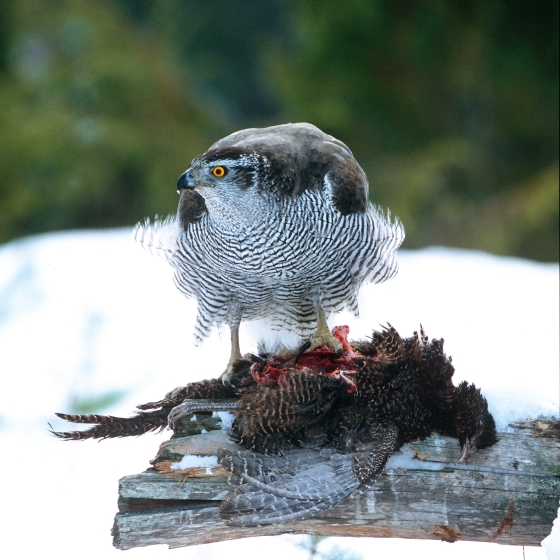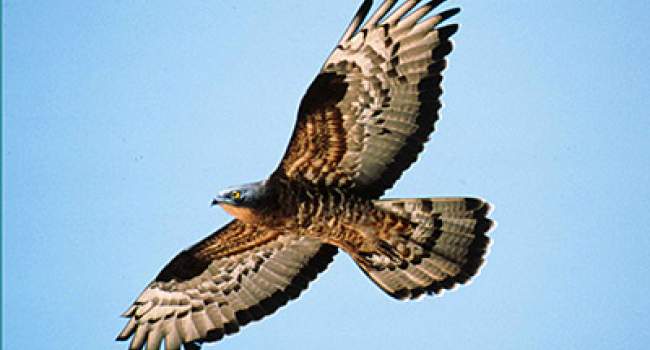Goshawk
Accipiter gentilis (Linnaeus, 1758)
GI
 GOSHA
GOSHA  2670
2670

Family: Accipitriformes > Accipitridae

This large and powerful bird is easily overlooked, its presence most readily revealed during the early breeding season when individuals make display flights over their woodland territories.
The Goshawk was an extremely rare bird historically, and may even have been lost from our shores as a breeding species during the late 1800s. Increasing numbers of records from the 1960s have been linked to escaped or deliberately released captive birds, and it is from these beginnings that our current population originates.
Now a widespread bird across much of Wales and southern Scotland, other populations show a more discrete distribution, often centred on large expanses of forest or woodland – e.g. the New Forest, Thetford Forest. The species is the target of persecution, a factor that was implicated in its poor fortunes back in the 1800s.
Identification
Goshawk identification is often difficult. The following article may help when identifying Goshawk.
Identifying Common Buzzard and Honey-buzzard

Buzzard is a familiar bird, but in summer and during migration time there is always the chance of finding a Honey-buzzard. Would you be confident in identifying it? Have a look at this guide to help you tell the difference.
SONGS AND CALLS
Listen to example recordings of the main vocalisations of Goshawk, provided by xeno-canto contributors.
Begging call
Call
Develop your bird ID skills with our training courses
Our interactive online courses are a great way to develop your bird identification skills, whether you're new to the hobby or a competent birder looking to hone your abilities.
Browse training coursesStatus and Trends
Population size and trends and patterns of distribution based on BTO surveys and atlases with data collected by BTO volunteers.
CONSERVATION STATUS
This species can be found on the following statutory and conservation listings and schedules.
POPULATION CHANGE
This species was driven to extinction by the late 19th century, with the decline attributed to deforestation and persecution (Hollom 1957). The subsequent population is believed to have arisen from birds which have been deliberately or accidentally released by falconers from the 1960s and 1970s onwards (Marquiss & Newton 1982) with the numbers and range initially increasing very slowly and the distribution remaining patchy (Balmer et al. 2013). Rare Breeding Birds Panel data indicate that the Goshawk population has increased strongly across the UK over recent decades,with a mean of 712 breeding pairs reported for the five-year period 2015–2019; estimates from county recorders suggest a populaton of around 1,200+ pairs (Eaton et al. 2021).
DISTRIBUTION
Goshawks are resident, leading to similar patterns of distribution and abundance between seasons. Outside Wales and the Borders, the distribution comprises a number of clusters of occupied 10-km squares. Many territories are associated with large state-owned forests.
Occupied 10-km squares in UK
| No. occupied in breeding season | 525 |
| % occupied in breeding season | 17 |
| No. occupied in winter | 518 |
| % occupied in winter | 17 |
European Distribution Map
DISTRIBUTION CHANGE
There have been significant range expansions in both seasons. Some may be due to better coverage and reporting, but there has undoubtedly been a concurrent population increase.
Change in occupied 10-km squares in the UK
| % change in range in breeding season (1968–72 to 2008–11) | +1322.9% |
| % change in range in winter (1981–84 to 2007–11) | +344.5% |
SEASONALITY
Goshawks are present year-round but recorded most often in late winter/early spring during spring aerial displays.

Movement
Information about movement and migration based on online bird portals (e.g. BirdTrack), Ringing schemes and tracking studies.
RINGING RECOVERIES
View a summary of recoveries in the Online Ringing Report.
Foreign locations of birds ringed or recovered in Britain & Ireland

Biology
Lifecycle and body size information about Goshawk, including statistics on nesting, eggs and lifespan based on BTO ringing and nest recording data.
SURVIVAL & LONGEVITY
View number ringed each year in the Online Ringing Report
Maximum Age from Ringing 
|
18 years 8 months 27 days (set in 2009) 
|
Typical Lifespan 
|
7 years with breeding typically at 2 year |
Adult Survival 
|
0.83±0.09  
|
Juvenile Survival 
|
0.4 (to age 2) 
|
CODES & CLASSIFICATION
Ring size 
|
G (males) H (females) |
Field Codes 
|
2-letter: GI | 5-letter code: GOSHA | Euring: 2670 |
For information in another language (where available) click on a linked name
Research
Interpretation and scientific publications about Goshawk from BTO scientists.
CAUSES AND SOLUTIONS
Causes of change
The UK population originates from birds deliberately or accidentally released by falconers during the 1960s and 1970s (Balmer et al. 2013). The localised pattern of such releases and high levels of illegal killing are believed to have influenced the patchy distribution of this species across the UK (Marquiss et al. 2003), as it is slow to disperse and colonise new breeding areas. Goshawks in the UK are often associated with large forests, often conifer plantations and this may influence their distribution in the UK, although some continental populations do breed in urban areas. Habitat quality and weather during the breeding season and in autumn were the most important drivers of population growth rate in a German population (Krüger & Lindström 2001); similar factors could be influencing the trend in the UK, but this should not be assumed as the range expansion of the UK population is ongoing and the relative importance of these factors and other factors may be different.
PUBLICATIONS (1)
Exploring the lives of Goshawks in the Brecks: identifying patterns in nest behaviour, habitat use and movements within and beyond the Brecks
Links to more studies from ConservationEvidence.com
Would you like to search for another species?











Share this page